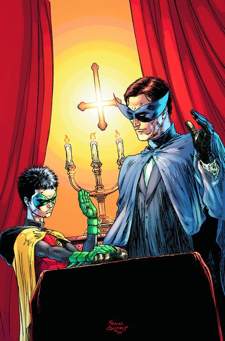Welcome to Wednesday Comics Pull-List, here on Tor.com! Every week we post reviews of a select handful of this week’s comic releases. From those reviews, we let you know what we would pull for keeps.
This week’s batch includes:
- Pilot Season: 7 Days From Hell #1
- Batman & Robin #15
- The Calling: Cthulhu Chronicles #4
- Carnage #1 (of 5)
- CBGB #4 (of 4)
- Ghostbusters: What in Samhain Just Happened?
- Kick-Ass 2 #1
The Tor.com comics team recommends all but two of the above books. (And those two are definitely not Kick-Ass or Batman & Robin.)
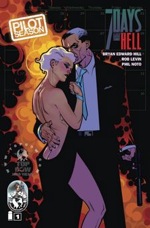 Pilot Season: 7 Days From Hell #1
Pilot Season: 7 Days From Hell #1
Written by Bryan Edward Hill
Art by Brian Stelfreeze
(Top Cow)
Pull: At long last, yes! Top Cow should drop the lame Hollywood-pitch-factory crap and start putting out more new titles like 7 Days From Hell. – Matt
Yes! – Annie
Matt says: 7 Days From Hell is a metaphysical twist on a 100 Bullets-like setup: a simple, repeatable (and violent) premise using a handful of recurring characters and allowing for almost infinite variations. In this case, the premise is that John Bishop—a mercenary and assassin—has just been killed. On his way to hell, his soul is intercepted by a demon, who offers him a deal: she’ll give him a target, and he’s got seven days to kill the target. If he succeeds, she gives him another target. If he fails, he finishes his trip to hell. So the demon—“Mandy”—is all that stands between John and the bullet in his brain; between John and hell.
Hill and Levin fall into some of the standard comic book writing traps (especially for first issues), hamfistedly shoe-horning some blatant (and largely unnecessary) exposition into the dialogue, but overall they succeed where it counts. As a first issue, this one manages to both tell a complete story and set up a compelling premise for future issues. They’ve given us a couple of believable characters, and the basics of a world in which these characters operate. Best of all, this is the first of Top Cow’s 2010 “Pilot Season” books that hasn’t simply read like a hastily-published movie pitch. In fact, 7 Days From Hell is the first “Pilot Season” book so far this year to feel like it should be a comic; you could turn this one into a movie, or a (cable) TV series—but it will probably be better as a comic.
Finally, I’ve saved the best part of 7 Days From Hell for last: the artwork. Phil Noto (an artist included in this past week’s edition of A is for Artist on Tor.com) is an artist worth following, and his work on 7 Days does not disappoint. Smooth storytelling and elegant linework meet “punchy” colors and a 70s spy-movie aesthetic. As a little icing on the cake, Brian Stelfreeze drops a cover onto issue #1 that’ll knock your socks off.
Annie says: 7 Days From Hell is unique and well written. So unique and well written that it was hard to remember that this was a first issue and not a 10th issue.
We’re introduced to John Bishop in a very Tarantino-inspired way (the beginning of the comic is really the end of the comic). John is working as a mercenary until a novice mistake takes his life. We actually get to watch as John is taken from Earth into hell and the illustrations are gorgeous. It’s a bit Watchmen-inspired (see the transition of Dr. Manhattan) but unique in its own right.
The best part of this comic were the quick transitions between locations and activities. John is given his assignment in hell, wakes up to find himself in Barcelona, and four panels later we’re 24 hours away from the demon’s deadline. I could be alone in this thought process but I am so for speeding up to get through the sometimes unnecessary bits of information. (This might have been where Cthulhu Chronicles went wrong.) They eliminated the need to introduce more characters which means, as long as they keep it this way, that we’ll learn a lot more about John and Mindy in future issues.
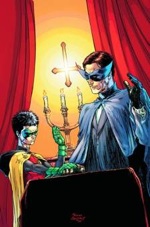 Batman & Robin #15
Batman & Robin #15
Written by Grant Morrison
Art by Frazer Irving, Frank Quitely
(DC Comics)
Pull: Five words (highlight if you want to be spoiled): The Return of Thomas Wayne. YES.
Annie says: I’m sitting here at my desk, with the comic closed and the most devilish grin on my face; we’re talking Joker devilish, guys. This comic is good. Part of my soul is shattering as I type this, but, Grant Morrison has murdered this issue. There’s no comparing it to anything else because there’s nothing like it. Just when you think all of Gotham is screwed, another twist is thrown in and you almost kick yourself for not figuring it out.
One of the best parts of this comic is how all of the prior issues are looped in, if you remember, Dick Grayson and Damien Wayne are trying to take down Professor Pyg and Dr. Hurt, the two men who destroyed Batman (Bruce Wayne). Robin finds himself still in the clutches of the Joker but being released into the woods because Joker (in his ultimate wisdom) knows Robin will go to Dr. Hurt to rescue Dick. Joker isn’t disappointed when Robin is taken back to Dr. Hurt’s hideaway after trying to take on Professsor Pyg and an entire truck full of his zombies. Robin is overpowered and reunited with Dick. Dr. Hurt gives him an ultimatum: join me and save Dick or you both die. I can’t tell you what happens next but, believe me, it’s not only worth reading, it’s imperative if you plan on picking up Morrison’s upcoming series’ Batman Inc.
There are so many good things about this comic. The artwork is seamless. The opening panels with Joker and his skeleton bride should remind you of not only how absolutely, brilliantly maniacal he is but really shows the reader how important he is to Batman’s legacy. Not that you needed reminding…
 The Calling: Cthulhu Chronicles #4
The Calling: Cthulhu Chronicles #4
Written by Johanna Stokes and Michael Alan Nelson
Art by Christopher Possenti
(Boom! Studios)
Pull: Might as well, it’s the last issue for this story arc.
Annie says: Picking up where we left off in issue #3, Clay and Stefano had recruited some other people to help them stop The Dreamer. Issue #3 was a bit unimpressive but I remained strangely hopeful that there would be some clarification in issue #4. There were bits of elucidation in this comic but nothing that made up for how confusing the last issue was.
The premise for the overall story was brilliant; a pharmaceutical companys ploy to not only dominate the medical arena but to branch further into mind control. It’s a pretty scary idea but totally plausible. The problem that arose was the last minute character additions to the team formally known as Clay and Stefano. This story was great for the first two issues but then throwing in a lot advertising/marketing jargon and mixing that with a serious pharmaceutical conspiracy theory, it quickly breached the realm of believability. It would have been one thing if they had just kept the conspiracy and didn’t add in so many things last minute. It would just seem to me that throwing in a twist in the third and fourth issues wouldn’t be in the author’s best interest. Once I thought I had some things figured out—or at least identified the roles each character was playing—a wrench was thrown in and, unfortunately, my interest quickly dissipated.
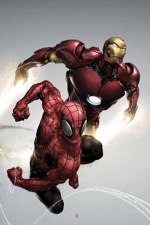 Carnage #1 (of 5)
Carnage #1 (of 5)
Written by Zeb Wells
Art by Clayton Crane
(Marvel Comics)
Pull: If you like Spider-symbiotes, and/or if you’re hard-up for a Spider-Man fix this week, then sure. If not, then give it a miss; if the series improves dramatically, you’ll be able to pick it up in trade a year from now anyway.
Matt says: I’ll admit that I was never one of the symbiote-crazy Spider-fans. Sure, there have been some good Venom stories over the years (though, alas, Spider-Man 3 was not one of them…), and Carnage has occasionally been used well. But for me, the point has always been about Spider-Man; so the idea that the more mindless of the symbiotic characters might need its own miniseries had me a little skeptical from the start. That said, I tend to like Zeb Wells (who, I should note, does seem to be one of those symbiote-crazy people), and I’m still making up my mind about Clayton Crain—so I figured I’d give this one a shot.
As first issues go, Wells knows his craft; he presents and resolves a basic situation across the 22 page issue, simultaneously setting up the plot for the rest of the 5-issue miniseries. And while there is some blatant exposition shoved into the dialogue, by and large the dialogue is well-written and (crucial for a Spider-Man story) witty. Both Spider-Man and Iron Man are in character—and even though we don’t see her, Pepper Potts manages (over the phone) to sound great, too.
I’m sorry to report that I’m still making up my mind on Clayton Crain. As a digital painter, he’s one of the best; none of the stiffness that plagues better-known painters like Greg Horn (or even, on the traditional side of things, Alex Ross…), and the storytelling is usually pretty good. But Crain has a tendency to get a little muddy, and there are some panels in Carnage #1 where you’ll just have to assume you know what’s going on—because the messy blob of dark colors isn’t going to help you out much.
To risk damning with faint praise, Carnage #1 wasn’t bad. I can’t say that by the end I was really excited to see what happens next, but nor was I sorry I had read the first issue. (Marvel promises, in a note at the end of issue #1, “Carnage will come out every two months, but you will wish it came out more often.” This did not turn out to be true for me.) The dialogue was sharp, and the art was slick; but I’m left about as lukewarm as I began. Like I said to begin with: for me, the point has always been interesting characters like Peter Parker (and/or Tony Stark). They show up here, and they say funny things and make for great action sequences…but so far, this book doesn’t really feel like it’s about anybody or anything. It’s just a bunch of characters bumping into each other so far. I suppose that if I was the sort to get excited about mindless symbiotes, that might be enough. But for this Spider-fan, I’m going to need a little bit more subtlety and character development if I’m going to see this miniseries through to the end.
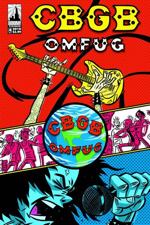 CBGB #4 (of 4)
CBGB #4 (of 4)
Written by Kim Krizan
Art by Toby Cypress
(Boom! Studios)
Pull: Yes; give yourself an indulgent moment to let the nostalgia wash over you, and enjoy two fresh, well-crafted tales.
Matt says: The nostalgic myth-making continues this month in the final issue of CBGB (OMFUG). All four issues have brought us a nostalgic looking-back at CBGB’s “glory days” that wistfully said, “Man, it was awesome—you should have been there.” Each story seemed to riff on the same three chords, as it were, painting a picture of CBGBs as a self-aware center of rebellious awesome, a temple of counterculture now sadly lost forever. If there is some truth to this picture, it is also far too uncritically accepting of the punk mythos. In this sense, of course, the book accurately reflects the culture for which it’s named; American punk has always seemed a little wistful for the “good old days” that never really were, and a little too quick to say “Sorry, man—the party’s over and you missed it. You really should have been there.”
Kelly Sue DeConnick and Chuck BB bring us “Count 5 or 6,” the first of the two tales in this month’s issue. The “party” that’s over in this case isn’t just CBGB, it’s New York City; the protagonist and her husband were once a part of the CBGB party scene, but now they’ve grown up, had some kids, and it’s time to move to Portland (Oregon or Maine, we do not know). Tex, now a mother of two, reflects on how quickly life moves by; there’s a nice “slow down and enjoy the ride” theme here, but it’s overridden by the larger moral: “I hate to break up the party but it’s time to move on, you guys.” This is a story about all of your friends who reach their 30s, “settle down,” start having kids, and say, “I’m too old for that stuff now.” But it’s a story that uncritically accepts the mindset of these friends; “Yes,” DeConnick and BB seem to say, “punk is kids’ stuff—we’re grown ups now, and it’s time to put away childish things…”
R. Eric Lieb and Dave Crossland, meanwhile, uncritically repeat yet another bit of pop-culture-punk wisdom in their story “No Future”: that rebellion is about “feeling” instead of “thinking,” and that hanging out in loud bars talking to cute girls can make you a rebel. What I really like about “No Future,” though, is that this basic premise is given a little twist: the time-traveling protagonist in the story was sent back to CBGB and told not to interact with the locals, specifically because the Powers That Be wanted him to disobey. In partaking in a little “teenaged rebellion,” Davis unwittingly does exactly what They wanted him to do. I don’t think that Lieb and Crossland really intended this story as a sophisticated jab at consumerist “counterculture”—it reads far too schmaltzy-sentimental for that—but as an unwitting piece of social commentary, I’d say it’s one of the best of the series.
Overall, CBGB has been a little too nostalgic, a little too uncritically accepting of the CBGB mythos. But what else do you expect from a miniseries named after the legendary club itself? All of the stories may have had the exact same theme at heart, but as a collection of indie short stories around a common theme, this series has been great—and too short-lived. Each month has brought two different stories from two different (unknown!) creative teams, and each story has managed to be distinctive, fresh, and fun to read.
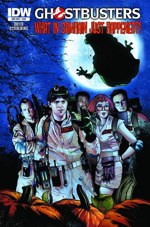 Ghostbusters: What in Samhain Just Happened?
Ghostbusters: What in Samhain Just Happened?
Written by Peter David
Art by Dan Schoening, Nick Runge
(IDW)
Pull: YES!
Annie says: The best parts of Halloween are the movie marathons they play and I will be so bold as to say that whenever Ghostbusters (one OR two, for that matter) is on TV, I’ll drop what I’m doing to watch it. The same thing goes for the comic because it’s comedic gold.
The character’s voices come through genuinely in this comic. Business is slow and that sassy office assistant, Janine, is asking for a raise. When the Ghostbuster’s explain they just can’t provide additional funds, Janine takes on a case with a reality TV show tycoon, Artie Lester, that the boys had turned down in lieu of privacy issues (Lester wanted to film the whole thing). It’s really cool to watch Janine flounder a bit initially, but she takes a hold of the situation and in a strange turn of events, actually gets the job done in her own unique way. I love comics like this. They’re easy to read and reliably enjoyable.
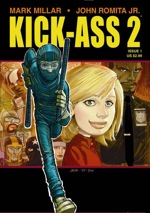 Kick-Ass 2 #1
Kick-Ass 2 #1
Written by Mark Millar
Art by John Romita, Jr.
(Marvel Comics)
Pull: It should be a life requirement. – Annie
Of course. Millarworld books are like True Blood: it feels like a guilty pleasure the whole time, but you still couldn’t pay me to stay away. And Kick-Ass is both the guiltiest and most pleasurable of the bunch… – Matt
Annie says: My favorite thing about the Kick-Ass comics is how casual, realistic, and specifically vulgar the conversations are between the superheroes. I’ve got sort of a biased opinion about these comics because the concept is absolutely brilliant and, perhaps not so secretly, I wish I was Hit Girl.
So Kick-Ass is a superhero now and has been recruited by Hit-Girl as her sidekick. I am totally for this. The fact that this little girl is well trained and making Kick-Ass jump through hoops to bring his experience level up to where she believes it should be creates such an amazing dynamic for these two characters. Mark Millar does a really great job of bringing the readers up to speed on what happened in Kick-Ass 1 through a series of flashbacks and casual dialogue between characters; so you don’t feel like an idiot while reading this issue if you’re new to the game.
Kick-Ass is on the brink of some major things here, namely, creating a unified team of superheroes. We find out towards the end of this issue that they’ll be called “Justice Forever.” Granted, the name could have been a little bit more intimidating but it travels in the same vein as the rest of the comic; an ode to all of the “real” superheroes that serve as role models to our beloved characters.
Matt says: Mark Millar points out something incredible in his thank-you note at the end of this issue: though Kick-Ass is already a worldwide, blockbuster phenomenon (a movie, a video game, tons of merchandise, and costumed fans galore—I saw at least a dozen Kick-Ass-related costumes at last week’s New York Comic Con, and I expect to see at least a score more before Halloween is over), this is only the ninth issue of the series. A pretty incredible run already; and an indication of just how much Millar and company can pack into these issues when they want to…
John Romita, Jr. has a little bit more help with the art chores this time around; he’s doing “breakdowns” and Tom Palmer finishes the pages in a full ink-wash. Dean White then colors the pages, and the end result feels a bit more loose and painterly (albeit also more “rendered”). Fortunately, Romita, Jr.’s “breakdowns” are a bit like Alan Moore’s “panel descriptions”—so detailed that they leave very little to chance or the whim of his collaborators. You probably won’t notice much difference from the first series, and the pages are still up to the same quality Romita, Jr. brought to them the first time around.
Millar returns to the central theme of Kick-Ass, here: the thin line between self-actualization and adolescent fantasy, between liberation and psychosis. In another flash-forward introduction, we’re given a glimpse of things to come before jumping back to pick up the narrative where the first Kick-Ass arc left off. It’s great to see each character set a little against his or her grain in this issue: Hit Girl is reigned in a bit by her family, while Kick-Ass is a bit more capable than he was the last time around. Finally, this issue introduces a major theme for the new series: teams. We’ve previously seen “team-ups” and partnerships, but Kick-Ass 2 promises to explore the world of full-on teams, both Avengers/JLA-style “super teams” (“superfriends”?) and teams of villains.
As a long-awaited follow up to the first series, issue #1 of Kick-Ass 2 does not disappoint. The characters, the world, and the poor-taste humor are all here. (Really? A Rihanna/domestic violence joke already in the first 3 pages? Welcome back to Millarworld…) And this book, like its predecessor, is going to keep you turning the page and anxious for more.
Annie Gala is Batman Young Money.
When Matt Lampert isn’t writing about comics, he’s a philosophy professor in New York City.










